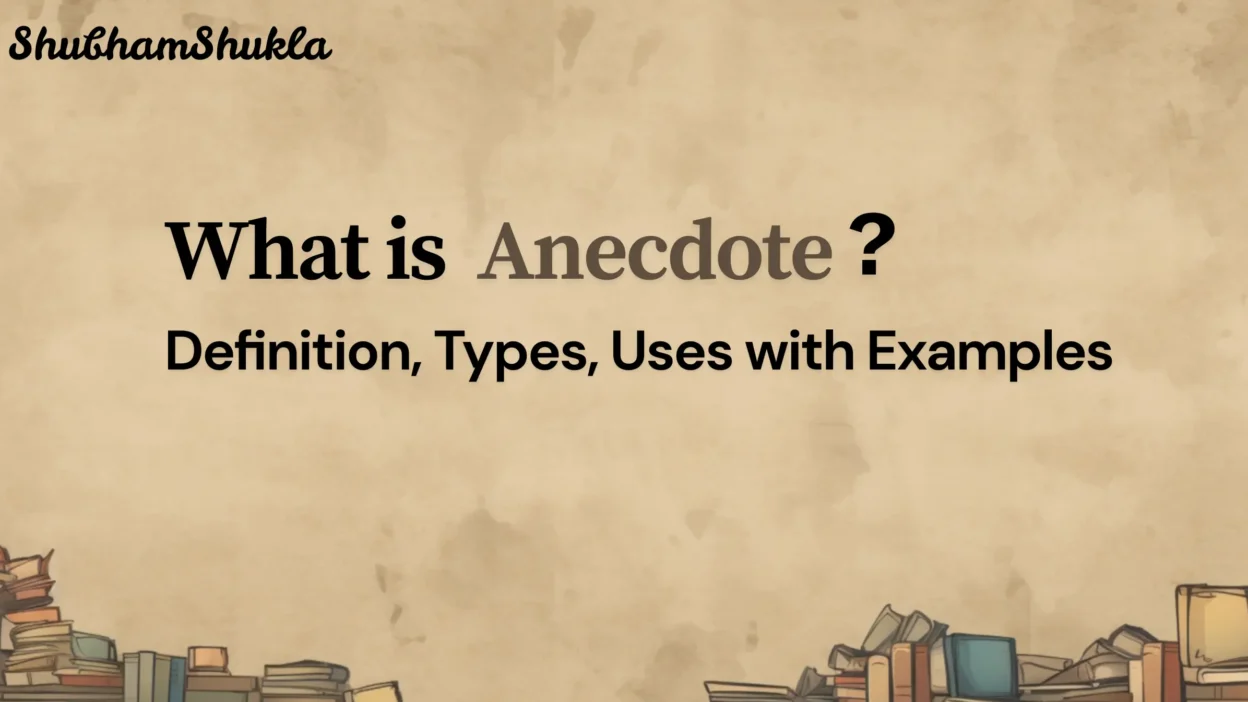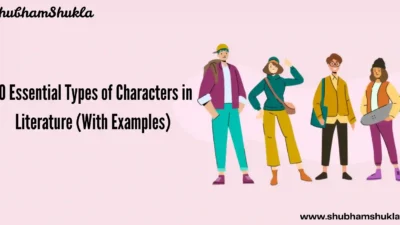What Is an Anecdote?
An anecdote is a short, interesting story about a real event or person. It’s often used to illustrate a point, spark interest, or deliver a message with emotional impact. Think of it like a mini-story that adds color to your conversation or writing.
Why Are Anecdotes So Effective in Communication?
Because stories stick. Our brains are wired for storytelling, not bullet points. Anecdotes help us connect emotionally, remember key ideas, and make abstract concepts feel real. Whether you’re chatting with a friend or giving a TED Talk, the right anecdote makes your message unforgettable.
You may also like: Powerful Adjectives to Describe a Person (With Examples & Tips)
Common Characteristics of a Good Anecdote
Brevity
Brevity is a key trait of a good anecdote, allowing it to convey a meaningful message without unnecessary details. Effective anecdotes are concise, capturing attention quickly and delivering impact in just a few sentences.
This brevity ensures the story remains engaging, avoids digression, and supports the main idea or lesson, making it suitable for speeches, articles, or everyday conversations.
Relatability
Relatability is an important characteristic of a good anecdote because it allows readers or listeners to engage with the narrative on a deeper level. When an anecdote refers to common experiences, feelings, or events, it becomes more engaging and impactful.
Relatable anecdotes frequently elicit empathy or shared understanding, making the message more memorable and reinforcing the aim of the story.
Emotional Connection
A good anecdote often creates an emotional connection with the reader or listener. By sharing personal or relatable experiences, it taps into universal feelings like joy, fear, or empathy.
This emotional engagement makes the story more memorable and impactful, allowing the audience to connect deeply with the message being conveyed, even if the anecdote is brief or simple.
Clear Message
An effective anecdote conveys a message that is clear and bolsters the main topic or theme. It should have a clear purpose that explains to readers why the story is important.
The message should be simple to understand, whether it is meant to entertain, caution, or inspire. An effective tale keeps the information clear, pertinent, and emotionally impactful, preventing misunderstandings.
You may also read: Top 10 Chetan Bhagat Books – #6 Will Leave You Speechless!
Major Types of Anecdotes
Personal Anecdotes
Personal Anecdotes are short, real-life stories drawn from an individual’s own experiences. These anecdotes often highlight everyday moments, challenges, or achievements, making them relatable and emotionally engaging.
Commonly used in speeches, memoirs, and blogs, personal anecdotes help build a connection with the audience by adding authenticity and a human touch to the message being conveyed.
Humorous Anecdotes
Humorous Anecdotes are light-hearted stories shared to entertain or amuse. Often drawn from everyday life, they highlight funny situations, misunderstandings, or quirks in human behavior.
These anecdotes are popular in speeches, conversations, and writing because they create an instant connection with the audience, relieve tension, and make messages more relatable through laughter and shared human experiences.
Philosophical or Moral Anecdotes
Philosophical or moral anecdotes frequently use a short narrative to demonstrate a greater truth or lesson, prompting thinking or meditation.
These anecdotes are intended to illustrate ethical concepts or philosophical ideas using realistic settings. Commonly used in speeches, religious texts, or educational settings, they help simplify abstract concepts by grounding them in everyday experiences, making the message more impactful and memorable.
Inspirational Anecdotes
Inspirational Anecdotes are short, uplifting stories that aim to motivate or encourage readers. Often drawn from real-life experiences, these anecdotes highlight personal growth, resilience, or success after struggle.
Commonly used in speeches, self-help books, and educational settings, inspirational anecdotes connect emotionally with audiences and offer valuable life lessons, making them powerful tools for positive influence and reflection.
Cautionary Anecdotes
Cautionary Anecdotes are short stories that warn readers or listeners about potential dangers or mistakes. Often shared to highlight the consequences of poor decisions, these anecdotes serve as moral lessons or gentle warnings.
They are commonly used in speeches, classrooms, and literature to teach values, encourage safer behavior, or prevent others from repeating the same errors.
Historical Anecdotes
Historical anecdotes are brief, intriguing accounts about previous events or renowned people. These anecdotes emphasize key events, frequently providing previously unknown insights about leaders, discoveries, or historical turning points.
They are frequently used in speeches, writings, and films to provide context, encourage audiences, or humanize historical people, making complex events more relevant and remembered through storytelling.
You may also like: Top 10 R. K. Narayana Books You Must Read Before You Die
How to Use Anecdotes Effectively
In Everyday Conversations
Including tales in regular conversations can make them more engaging, relatable, and memorable. A well-placed personal tale can assist illustrate a point, lighten the mood, or establish relationships with others.
For example, telling a small tale about a childhood disaster during a session about learning from mistakes provides a human touch and keeps the listener interested. Anecdotes can also help break the ice in new social situations, making speaking feel more normal.
When utilized wisely, they help transmit emotions and beliefs without seeming preachy, making interactions more authentic and pleasurable for all parties involved.
In Public Speaking
In public speaking, tales are effective strategies for capturing attention, building rapport, and making messages more relevant. A well-chosen personal tale can quickly personalize the speaker, eliciting an emotional response from the audience.
Anecdotes simplify difficult ideas, making them easier to comprehend and retain. Stories add authenticity and believability to any speech, whether they are used to introduce or reinforce a major point.
To demonstrate resilience, a speaker on leadership may tell a brief narrative about a previous hardship. When utilized organically and concisely, anecdotes captivate listeners while also leaving a lasting impact that supports the speaker’s fundamental point.
In Writing and Storytelling
In writing and storytelling, anecdotes are effective techniques for engaging readers and making narratives more relevant.
A well-placed tale can illustrate a theme, highlight character attributes, or establish the tone of a piece. Writers frequently utilize personal or fictitious short tales to simplify complex ideas, elicit emotion, or provide context in an engaging manner.
Anecdotes in fiction contribute to depth and realism, whilst in nonfiction they bring authenticity and trustworthiness. Whether hilarious, passionate, or reflective, an anecdote may turn a dull paragraph into something vivid and fascinating, keeping the listener engaged from start to finish.
In Education and Teaching
In education and teaching too, anecdotes are effective tools for simplifying complicated topics and making learning more relatable. Teachers frequently utilize brief, personal tales to illustrate crucial topics, build emotional connections, and engage students.
A science teacher, for example, may present a real-life lab experience to better illustrate the scientific method. Anecdotes help to humanize the instructor, making them more approachable and trustworthy.
When appropriately put, these stories can improve memory recall, foster critical thinking, and create a more interesting classroom environment. Finally, anecdotes serve to bridge the gap between theory and practical practice.
In Marketing and Branding
Anecdotes are an effective way to emotionally connect with consumers in branding and marketing. Marketers can humanize a product or service by presenting brief, relatable stories, such a customer’s satisfying experience or a brand’s history.
These authentic moments help brands stand out in a competitive market by making them more enduring and reliable. Because they arouse feelings that data and characteristics by themselves frequently cannot, anecdotes are particularly powerful in advertising, social media campaigns, and brand storytelling.
When carefully employed, they inspire customer loyalty and reinforce company values in addition to engaging the audience.
You may also like: 18Teen Introspect Yourself a Book by Shubh Mittal: Book Review
Real-Life Examples of Anecdotes
Anecdote in a Classroom – “To teach empathy, I shared the story of a student who used to be bullied and how one act of kindness changed everything.”
Anecdote in an Article or Blog – “When I first started freelancing, I earned $5 for a 500-word article. I was thrilled. That humble beginning taught me to value progress over perfection.”
Anecdote in a Speech – “I still remember my first rejection letter. It was handwritten. The editor said, ‘Nice idea, poor execution.’ That letter pushed me to improve.”
Anecdote in Advertising –“Before using our skincare line, Jane had tried 15 different products. She thought clear skin was impossible. Then she found us.”
You may also like: 15 Romantic Aadvika Pommu Novels That Will Steal Your Heart
Tips for Writing Powerful Anecdotes
Start with a Hook
To make your anecdote truly engaging, begin with a strong hook that captures the reader’s attention immediately. A compelling opening line such as a surprising fact, a question, or vivid action draws readers into your story and sets the tone.
This hook should create curiosity and signal that something meaningful or entertaining is about to unfold. Whether it’s a moment of suspense or humor, starting strong helps your anecdote stand out and encourages readers to keep reading.
Keep the Focus
A powerful anecdote should center around a single, clear point to avoid confusing the reader. When writing, ensure every detail supports the main message or emotion you want to convey. Avoid including unnecessary background or side stories that dilute the impact.
Staying focused helps maintain the reader’s attention and strengthens the anecdote’s relevance to the broader topic or lesson. A tightly focused anecdote is often more memorable and meaningful for your audience.
Wrap it up with Lesson
When an anecdote concludes with a clear lesson or moral, it leaves a lasting impression. This concluding thought gives the personal narrative direction and significance by relating it to a more general idea or universal truth.
Whether the lesson is emotional, hilarious, or motivational, it enables readers to comprehend the significance of the story. Writers make sure their stories have lasting impact and support the primary idea or thesis by concluding with a relatable insight.
You may also like: Book Summary: The Art of Not Overthinking by Shaurya Kapoor
To Sum Up
Anecdotes aren’t just fun to tell, they’re powerful tools for connection, learning, and persuasion. Whether you’re writing a blog, giving a speech, or just chatting with friends, the right story can transform how your message is received. Mastering anecdotes is like having a magic key to your audience’s heart. So go ahead, share that story. Just make sure it means something.
Frequently asked questions
Q1: What’s the difference between an anecdote and a short story?
An anecdote is brief, factual (or mostly factual), and supports a point. A short story is a full narrative with developed characters and plot.
Q2: Can anecdotes be fictional?
Yes, but they’re often more effective when they’re real or based on real experiences.
Q3: Are anecdotes only used in speeches?
Not at all! They’re used in writing, marketing, teaching, casual talk, you name it.
Q4: How long should an anecdote be?
Ideally under 200 words. Just enough to make your point without dragging.
Q5: Can I use anecdotes in academic writing?
Sometimes, yes, especially in introductions or to humanize a topic. Just ensure it fits the tone and purpose of your piece.



